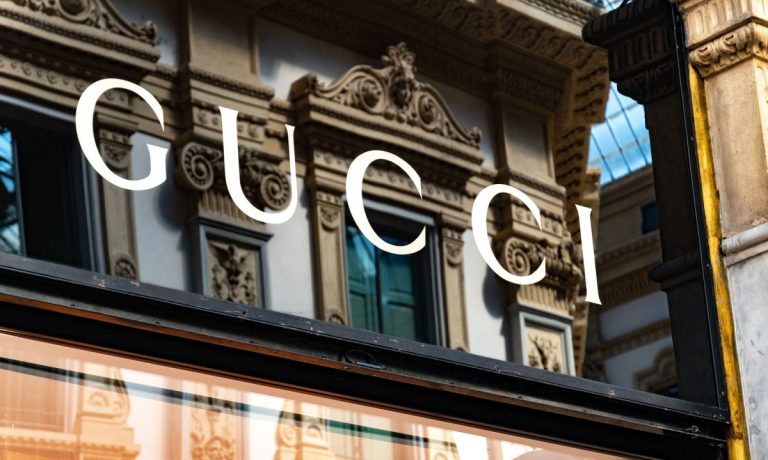
Los Angeles is now home to an impressive new luxury storefront by Gucci that is exclusively reserved for big-spending clients and A-list celebrities.
Following the departure of Marc Jacobs, Gucci initially used the location as a pop-up for its Adidas collaboration, but has since transformed it into a permanent brick-and-mortar concept called the Gucci Salon — which will only open its doors to VIP clients with prior appointments.
Melrose Place is famous for its upscale retail stores, and the Gucci Salon’s neighbors include illustrious brands such as Balmain, The Row, Oscar de la Renta and Chloé. The Gucci Salon is situated at the intersection of Melrose Place and Melrose Avenue, a bustling shopping district in West Hollywood.
The move signals a shift in focus for Gucci, which has in recent years made many attempts to align itself with Gen Z, from embracing resale to launching product-focused marketing tactics on social media platforms, specifically TikTok, eventually becoming the most popular luxury brand for Gen Z on TikTok. But in becoming more attainable, the brand lost its exclusivity.
While the luxury label isn’t walking back on those efforts, it is looking to better align with a cohort of consumers who can spend without giving it a second thought.
With the Gucci Salon, VIP clients can avoid the ordinary shopping experience and instead book an appointment. The space is customized to customers’ individual tastes and the racks are filled accordingly.
Luxury items are not immune from inflation, but the wealthiest consumers are less affected and can afford high-end products. By targeting these big-spending clients and celebrities with a store that caters specifically to their needs, Gucci can ensure continued sales despite rising prices.
Furthermore, by offering a store that focuses on exclusive and customized experiences, Gucci can appeal to customers who are looking for unique, high-end products they can’t find elsewhere.
This strategy applies to the 20% of “persuadable” customers who said price increases have not impacted their shopping habits, according to PYMNTS’ March report, “Consumer Inflation Sentiment: The False Appeal of Deal-Chasing Consumers.”
And the new store’s location on Melrose Place, known for upscale shopping, is ideal for Gucci’s target market. The store’s proximity to other luxury retailers and popular restaurants and cafes makes it an attractive destination for wealthy shoppers and celebrities and reinforces Gucci’s image as a purveyor of luxury and style.
Retailers of all sorts are dialing in on a customer and an experience that aligns with their brand positioning.
Dick’s Sporting Goods, for example, noted in its latest earnings report that even though consumers may be reducing their spending on non-essential items, they are still willing to spend on health and wellness products.
“We’ve seen a shift in consumer behavior where they are prioritizing athletic endeavor sports, health and active lifestyle, and they’re prioritizing Dick’s in order to meet those needs,” Dick’s Sporting Goods CEO Lauren Hobart said on a call with analysts.
See also: Retail CEOs Want Their Loyal Consumers Back, Reflecting on Q4 Earnings
Direct-to-consumer (D2C) shoe company Allbirds reported a shift in its focus back to its core demographic, consisting of 30 to 40-year-old affluent men and women interested in active lifestyles and urban exploration.
Allbirds also revealed that it has more potential with women than it initially realized. The company acknowledged that its performance in the previous year suffered due to a deviation from its core business focus.
To attract consumers with more spending power, the beauty industry has created campaigns targeting women over 50, who collectively have a purchasing power of $15 trillion.
Brands such as L’Oréal have partnered with industry icons like Helen Mirren (77), Jane Fonda (85), Viola Davis (57) and Maye Musk (74) — CoverGirl’s oldest model in 2017.
See also: Move Over Millennials: The Beauty Industry Wants Buyers With More Spending Power
Building on the Melrose Place effort, Gucci intends to introduce similar stores in other major cities, either as standalone Gucci Salons or dedicated sections within existing stores.
The Gucci Salon may be a new name, but its concept dates back to 1977 when Aldo Gucci, the son of founder Guccio Gucci, introduced the first Gucci Galleria with the aim of creating the most opulent shopping experience in the world.
The first Gucci Galleria was situated above the brand’s Beverly Hills store, while the second opened on the fourth floor of its New York City Fifth Avenue location in 1980. Only a select clientele was permitted to enter these stores via a crystal and bronze elevator, which was activated by a leather-wrapped brass key.
For all PYMNTS retail coverage, subscribe to the daily Retail Newsletter.